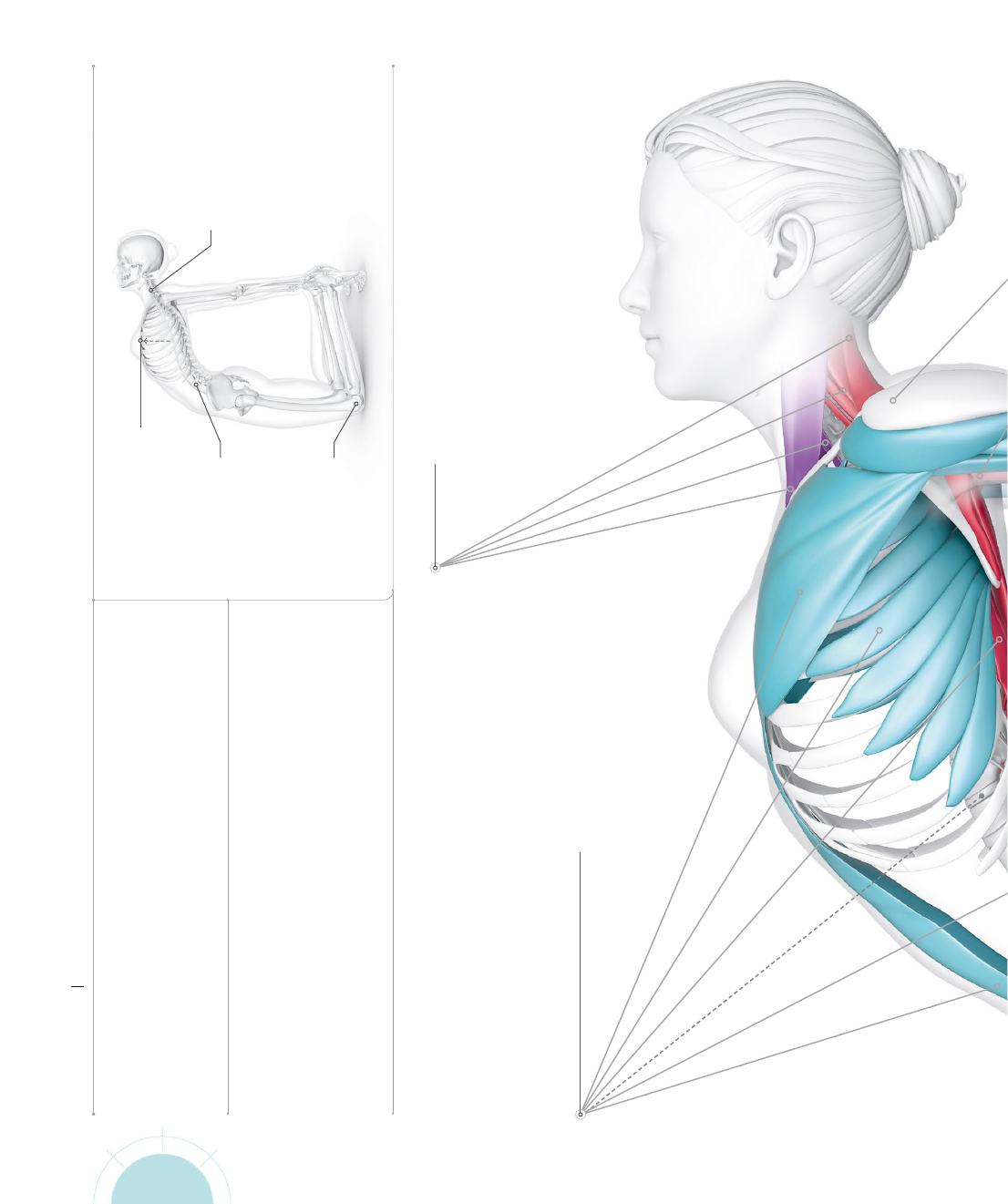
THE ASANAS Seated
Camel is an energetic backbend
that can leave you
feeling condent and ready to take on the day. This pose
counteracts our exion-driven modern lifestyles by
broadening the chest. It is challenging but can be
adapted for anyone who struggles to reach their feet.
THE BIG
PICTURE
The front of your body—including your abdominals and thighs—
stretches, while the back of your body—including your back
muscles, buttocks, and thighs—engages. You may also feel
stretching on the soles of your feet as you tuck your toes under.
CAMEL
Ustrasana
Torso
Your spinal extensors engage to extend your
spine while your abdominals stretch. Your
pectorals stretch as you broaden your chest.
Your middle and lower trapezius work with your
rhomboids to retract and stabilize your scapulae,
while your serratus anterior stretches.
Neck
Your cervical extensors engage to
extend your neck, while your cervical
exors stabilize, preventing your head
from being thrown back, and creating
an even, controlled curve.
ALIGNMENT
Your breastbone is lifting
up and neck is elongating
to create as even a backbend
as possible. Your knees and
feet are hip distance apart.
Keep backbend
as even as
possible
Breastbone
lifting up
Knees hip-
distance
apart
Neck elongating
with even curve
Teres major
Upper trapezius
Splenius muscles
Sternocleidomastoid
Longus muscles
Pectoralis major
Serratus anterior
Erector spinae
Quadratus lumborum
Spine
Rectus abdominis
US_076-077_Camel_01.indd 76 20/09/2018 20:46

77
Arms
Your posterior deltoids,
latissimus dorsi, and teres
major muscles engage
to extend your shoulders,
while your triceps extend
your elbows.
Thighs and lower legs
Your hip extensors engage to help you
lean back, while your hip exors stretch.
Your quadriceps engage and lengthen,
working with your hamstrings to stabilize
your thighs. Your ankle dorsiexors
engage to ex your ankles and extend
your toes. The strongest stretch may be
felt on the plantar region of your feet.
Deltoids
Teres major
Elbow
Biceps brachii
Triceps brachii
Knee
Semitendinosus
Biceps femoris
Vastus lateralis
Rectus femoris
Gluteus maximus
Hip
Iliopsoas
Tibialis anterior
Extensor digitorum longus
Flexor hallucis longus
Extensor hallucis longus
Ankle
Plantar muscles
Plantar fascia
KEY
Joints
Muscles
Engaging
Engaging while
stretching
Stretching
US_076-077_Camel_01.indd 77 20/09/2018 20:46

78
CAMEL
Ustrasana
CLOSER LOOK
Camel can be great for your posture and spinal disk
health. However, make sure you warm up first, and
take care with the position of your neck.
Abdominals mainly
stretch, perhaps with
some engagement
Intervertebral
disk
This subtle, controlled
neck extension protects
the small, complex
joint structures
Toes can be relaxed
or curled under
VARIATION
For a gentler backbend, press your
hands into your hips as you lean
back slightly into the pose. You
could also place your hands on
blocks set alongside your shins.
Gentle curve
through spine
Stabilize
your neck
Feet can
be relaxed
Vertebra
Spinal extension
Backbends (spinal extension) push your
intervertebral disks slightly forward, while
strengthening your back muscles. This is
great for the health of your disks, and can
be applied therapeutically for disk issues.
Consult your healthcare team and a qualied
yoga professional about your unique
conditions rst.
ANTERIOR–LATERAL VIEW
US_078-079_Camel_02.indd 78 20/09/2018 20:46

79
THE ASANAS
Seated
Counteract exion dominance
Our lifestyles place us in exion-dominant
positions when typing, texting, driving,
cooking, and more. Over time such
postures lead to muscle weakness and
tightness. Camel pose directly counteracts
these patterns through controlled
extension of your spine, shoulders, and
hips. Backbends also tend to be energizing
and a mood booster to combat fatigue.
Hands can
grasp ankles,
if accessible
Stretches
serratus
anterior
Stretches
pectoralis
major
Stretches
sternocleidomastoid
Strengthens
rhomboids
and trapezius
Dropping head
back increases
risk of vertebral
artery damage
and stroke
Vertebral artery
Cardiovascular risk
There have been rare reports of
injury in cervical hyperextension,
including joint damage, impaired
blood ow, and stroke. The risk
is increased for the elderly,
though more women in their
20s–40s are having strokes.
Risk factors include prolonged
use of birth control, migraines,
pregnancy, and smoking.
Quadriceps
engage while
lengthening
Gaze lifted but
neck does not
reach back
POSTERIOR–
LATERAL VIEW
US_078-079_Camel_02.indd 79 20/09/2018 20:46
..................Content has been hidden....................
You can't read the all page of ebook, please click here login for view all page.
